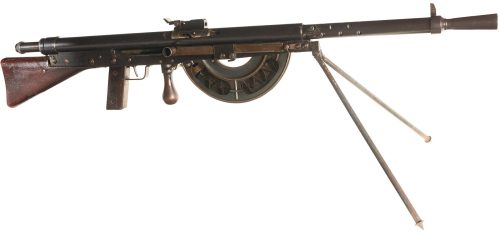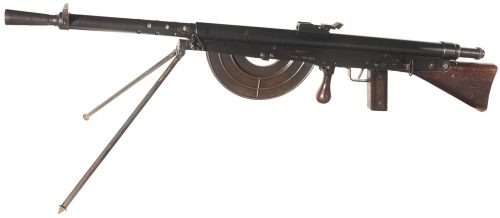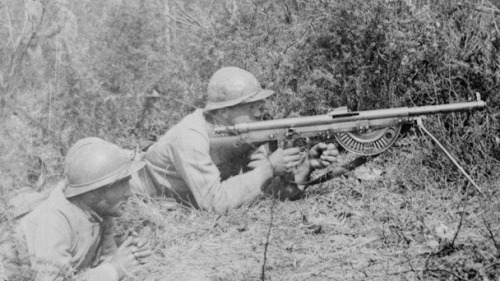Was the Chauchat Really That Bad?The Chauchat has a reputation as the worst light machine gun of all
Was the Chauchat Really That Bad?The Chauchat has a reputation as the worst light machine gun of all time, however is such a reputation deserved? After all, the Chauchat has some pretty stiff competition, such as the Breda 30 and the Japanese Type 11. Was it really as bad as its is supposedly claimed to be? The short answer is both a resounding yes and a conservative no. The long answer is much more complicated.When it comes to the Chauchat, there were two dominant models, the Mle 1915, which was used by France and 8 others nations during World War I, and the Mle 1918, which was used by the United States at the end of the war. The Mle 1915 was invented by Colonel Louis Chauchat between 1903 to 1909 and first manufactured by MAS, and later Gladiator and Sidarme. It was first produced in limited numbers in 1913 and entered full production in 1915. Fed from a 20 round detachable magazine in 8mm Lebel, it utilized a long recoil action based upon the designs of John Browning. When the Chauchat first hit the battlefields of World War I, its design flaws and limitations immediately became apparent. The Chauchat only had one major mechanical flaw; it tended to overheat very quickly, which caused it to seize up until it cooled. A minor problem was its long recoil system, which was not really intended for fully automatic firearms, thus giving the weapon a stout recoil. The Chauchat’s overheating problem was solved by reducing its firing rate to 250 RPM, while French soldiers were encouraged to fire short, precise bursts, to save ammunition mostly.The biggest issue with the Chauchat was not it’s mechanics, but its magazine. After a review of Chauchat performance commissioned by Gen. Petain, it was determined that 75% of malfunctions were a result of it’s magazine. While the gun itself was well made, manufacturers really skimped on magazine quality. They tended to be very fragile; bending and warping easily. They also tended to have faulty or defective springs which exerted too much tension, often causing first round failure to feed. As a result, French gunners tended to load the magazines with 18 or 19 rounds instead of topping them off. Generally French soldiers tended to only use the best magazines of the batch, discarding those with bad springs or flimsy construction. The biggest problem with the magazine was that it had open sides so that the soldiers could see how much ammo was left. However this feature made the Chauchat susceptible to dust , dirt, mud and other particulates. French soldiers mitigated this problem by improvising coverings over the magazine, and sometimes over the gun itself. Later canvas coverings were issued. By 1916 most of the problems of the Chauchat were resolved or minimized. What resulted was a light machine gun that was functional and practical. It wasn’t awesome, but it wasn’t bad either. It could be best described as adequately mediocre. Keep in mind that during most of World War I, there were only two light machine guns, the Chauchat, and the Lewis gun. Light machine guns were new technology that were in their infancy. The Browning Automatic Rifle wouldn’t be invented until 1917, and wouldn’t really see a lot of action until the closing months of the war. There were a handful of other designs, but none in appreciable qualities. So really, the Chauchat was one of only a few options when it came to light machines guns. Comparing it further to the Lewis gun, it was much lighter at 20 lbs, and much more compact and easier to wield by one person. Throughout the war, the French used the Chauchat to great effect. The most common tactic was the “walking fire” maneuver, where light machine gunners armed with Chauchats would fire while moving, providing covering fire for advancing infantry. Such tactics would become a staple of WWI trench warfare. It must also be realized that the Chauchat was very new, and like most things new had many bugs to be worked out. While the Lewis gun is regarded as one of the best light machine guns of WWI, it too had its problems in its early years. Designed in the US, it was rejected in US Army Ordnance Trials after it suffered 260 malfunctions, then completely broke down. It was only after some trial and error that the Lewis gun became what it was. Even the BAR had some hiccups early in its production history.So overall the Chauchat Mle 1915 was an all around decent light machine gun. Not necessarily a fantastic design like the Mormon magic that was the BAR, but not necessarily the piece of crap that it is generally thought to be. Then came the Mle 1918. The Mle 1918 is what gave the Chauchat its shitty reputation. It truly was a steel turd of epic proportions. They should have called it the Chaushit instead. When the American Expeditionary Force landed in France in 1918, it had few tanks, airplanes, artillery, heavy machine guns, and light machine guns of its own. Thus, such weapons were mostly supplied by the French. The Mle 1918 was a variant of the Chauchat chambered in the American .30-06 cartridge and manufactured by Gladiator. The .30-06 was a very powerful cartridge (7.62x63mm). While the Chauchat’s overheating problem was manageable in 8mm Lebel (8X50mmR), the new powerful cartridge exacerbated it, causing it to overheat and lock up rapidly. The French knew little about manufacturing firearms in .30-06 dimensions and manufacturing was rushed. As a result there were many dimensional defects of the chamber which caused jams and failure to feed. With its long recoil action combined with the powerful .30-06 cartridge, its must have kicked like a jackhammer when fired. Essentially, the Mle 1918 was almost completely non-functional for practical combat use, and as a result most American soldiers discarded them as worthless junk. When the problems with the Mle 1918 became apparent, the French issued Mle 1915 models to the Americans instead. By the end of the war, most Chauchats issued to the AEF of either model were replaced by the Model 1918 BAR. -- source link
Tumblr Blog : peashooter85.tumblr.com
#guns#firearms#machine guns#chauchat#wwi#history#gunblr



